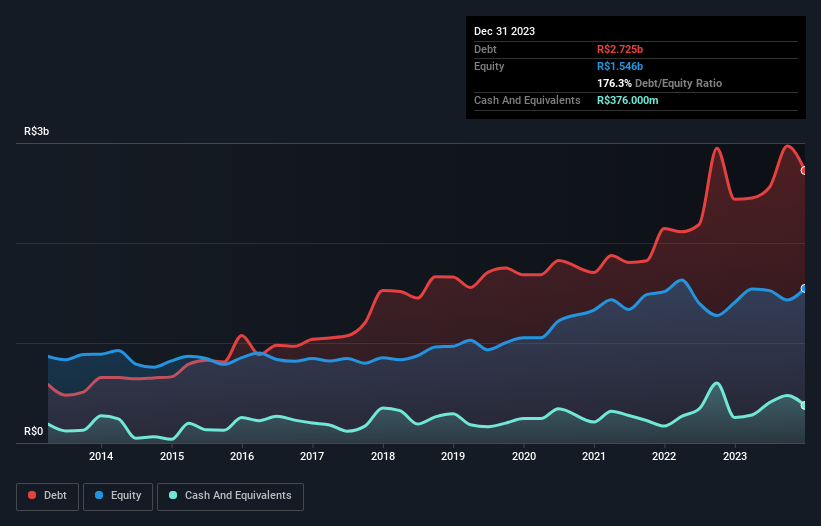- Brazil
- /
- Electric Utilities
- /
- BOVESPA:CSRN3
We Think Companhia Energética do Rio Grande do Norte - COSERN (BVMF:CSRN3) Is Taking Some Risk With Its Debt

Legendary fund manager Li Lu (who Charlie Munger backed) once said, 'The biggest investment risk is not the volatility of prices, but whether you will suffer a permanent loss of capital.' So it seems the smart money knows that debt - which is usually involved in bankruptcies - is a very important factor, when you assess how risky a company is. We can see that Companhia Energética do Rio Grande do Norte - COSERN (BVMF:CSRN3) does use debt in its business. But the more important question is: how much risk is that debt creating?
When Is Debt A Problem?
Generally speaking, debt only becomes a real problem when a company can't easily pay it off, either by raising capital or with its own cash flow. If things get really bad, the lenders can take control of the business. However, a more common (but still painful) scenario is that it has to raise new equity capital at a low price, thus permanently diluting shareholders. Of course, the upside of debt is that it often represents cheap capital, especially when it replaces dilution in a company with the ability to reinvest at high rates of return. The first thing to do when considering how much debt a business uses is to look at its cash and debt together.
Check out our latest analysis for Companhia Energética do Rio Grande do Norte - COSERN
What Is Companhia Energética do Rio Grande do Norte - COSERN's Net Debt?
The image below, which you can click on for greater detail, shows that at December 2023 Companhia Energética do Rio Grande do Norte - COSERN had debt of R$2.73b, up from R$2.44b in one year. However, it does have R$376.0m in cash offsetting this, leading to net debt of about R$2.35b.

A Look At Companhia Energética do Rio Grande do Norte - COSERN's Liabilities
Zooming in on the latest balance sheet data, we can see that Companhia Energética do Rio Grande do Norte - COSERN had liabilities of R$1.45b due within 12 months and liabilities of R$2.67b due beyond that. On the other hand, it had cash of R$376.0m and R$891.0m worth of receivables due within a year. So it has liabilities totalling R$2.85b more than its cash and near-term receivables, combined.
This is a mountain of leverage relative to its market capitalization of R$4.60b. This suggests shareholders would be heavily diluted if the company needed to shore up its balance sheet in a hurry.
We use two main ratios to inform us about debt levels relative to earnings. The first is net debt divided by earnings before interest, tax, depreciation, and amortization (EBITDA), while the second is how many times its earnings before interest and tax (EBIT) covers its interest expense (or its interest cover, for short). The advantage of this approach is that we take into account both the absolute quantum of debt (with net debt to EBITDA) and the actual interest expenses associated with that debt (with its interest cover ratio).
Companhia Energética do Rio Grande do Norte - COSERN has net debt worth 2.1 times EBITDA, which isn't too much, but its interest cover looks a bit on the low side, with EBIT at only 4.5 times the interest expense. While these numbers do not alarm us, it's worth noting that the cost of the company's debt is having a real impact. Importantly Companhia Energética do Rio Grande do Norte - COSERN's EBIT was essentially flat over the last twelve months. Ideally it can diminish its debt load by kick-starting earnings growth. When analysing debt levels, the balance sheet is the obvious place to start. But you can't view debt in total isolation; since Companhia Energética do Rio Grande do Norte - COSERN will need earnings to service that debt. So if you're keen to discover more about its earnings, it might be worth checking out this graph of its long term earnings trend.
Finally, while the tax-man may adore accounting profits, lenders only accept cold hard cash. So we clearly need to look at whether that EBIT is leading to corresponding free cash flow. Looking at the most recent three years, Companhia Energética do Rio Grande do Norte - COSERN recorded free cash flow of 32% of its EBIT, which is weaker than we'd expect. That's not great, when it comes to paying down debt.
Our View
Both Companhia Energética do Rio Grande do Norte - COSERN's level of total liabilities and its conversion of EBIT to free cash flow were discouraging. At least its EBIT growth rate gives us reason to be optimistic. We should also note that Electric Utilities industry companies like Companhia Energética do Rio Grande do Norte - COSERN commonly do use debt without problems. We think that Companhia Energética do Rio Grande do Norte - COSERN's debt does make it a bit risky, after considering the aforementioned data points together. Not all risk is bad, as it can boost share price returns if it pays off, but this debt risk is worth keeping in mind. The balance sheet is clearly the area to focus on when you are analysing debt. But ultimately, every company can contain risks that exist outside of the balance sheet. Be aware that Companhia Energética do Rio Grande do Norte - COSERN is showing 3 warning signs in our investment analysis , and 1 of those can't be ignored...
When all is said and done, sometimes its easier to focus on companies that don't even need debt. Readers can access a list of growth stocks with zero net debt 100% free, right now.
If you're looking to trade Companhia Energética do Rio Grande do Norte - COSERN, open an account with the lowest-cost platform trusted by professionals, Interactive Brokers.
With clients in over 200 countries and territories, and access to 160 markets, IBKR lets you trade stocks, options, futures, forex, bonds and funds from a single integrated account.
Enjoy no hidden fees, no account minimums, and FX conversion rates as low as 0.03%, far better than what most brokers offer.
Sponsored ContentNew: AI Stock Screener & Alerts
Our new AI Stock Screener scans the market every day to uncover opportunities.
• Dividend Powerhouses (3%+ Yield)
• Undervalued Small Caps with Insider Buying
• High growth Tech and AI Companies
Or build your own from over 50 metrics.
Have feedback on this article? Concerned about the content? Get in touch with us directly. Alternatively, email editorial-team (at) simplywallst.com.
This article by Simply Wall St is general in nature. We provide commentary based on historical data and analyst forecasts only using an unbiased methodology and our articles are not intended to be financial advice. It does not constitute a recommendation to buy or sell any stock, and does not take account of your objectives, or your financial situation. We aim to bring you long-term focused analysis driven by fundamental data. Note that our analysis may not factor in the latest price-sensitive company announcements or qualitative material. Simply Wall St has no position in any stocks mentioned.
About BOVESPA:CSRN3
Companhia Energética do Rio Grande do Norte - COSERN
Engages in the distribution, transmission, and transmission of electricity in Brazil.
Established dividend payer with adequate balance sheet.
Market Insights
Community Narratives




